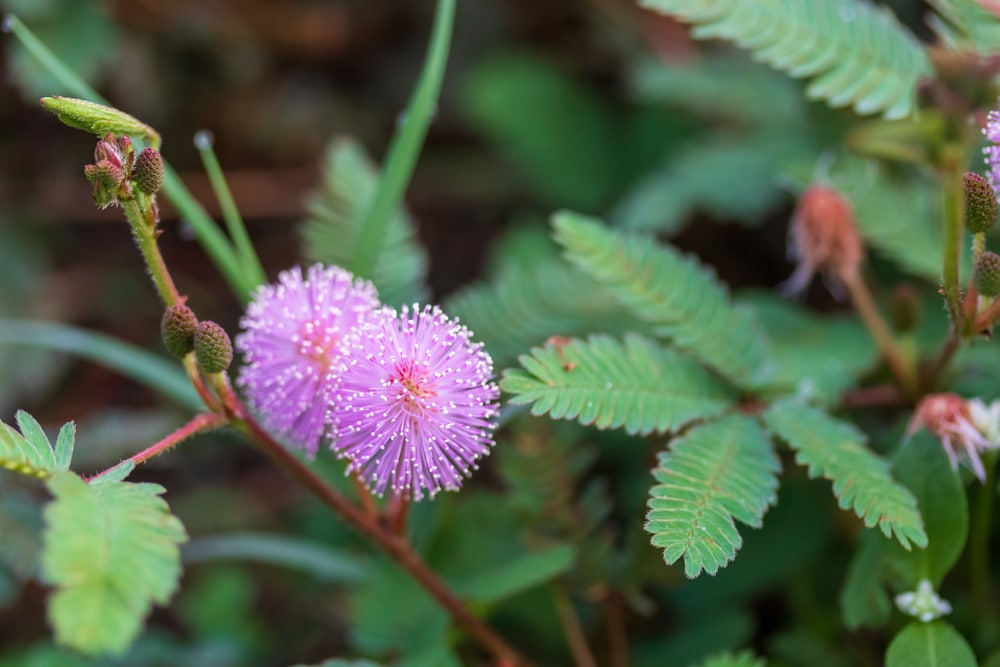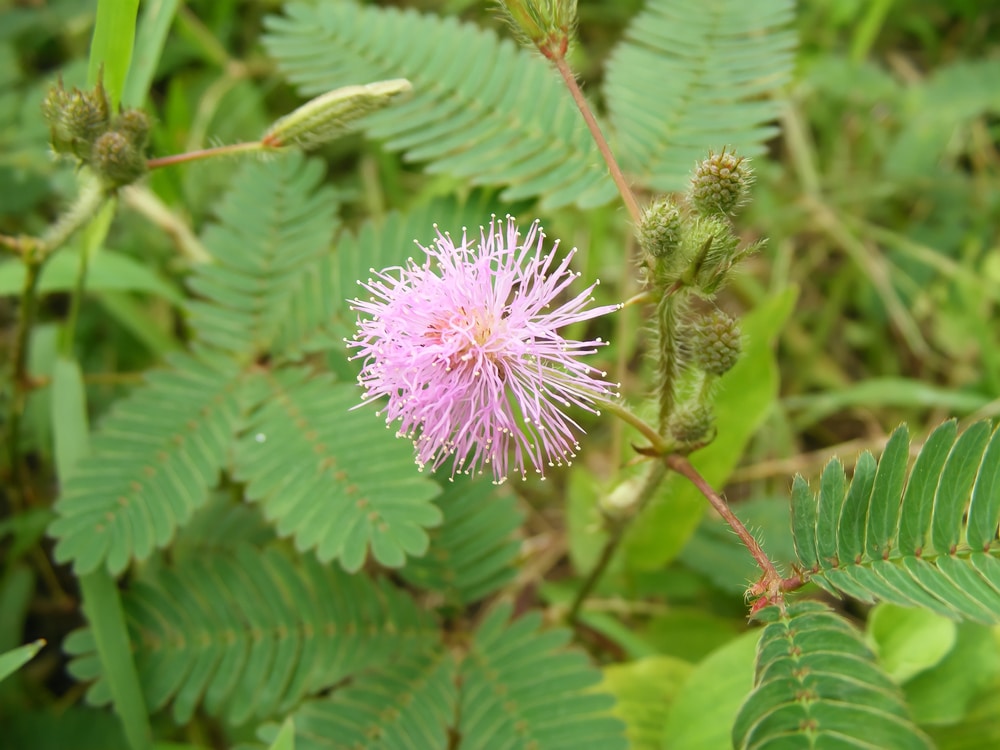Landscapes are not complete without a few Mimosa plants. The Sunshine Mimosa (Mimosa Strigillosa) is a fast-growing, drought-tolerant, deciduous tree that can quickly turn your yard from drab to fab. This plant is distinctively characterized by its fern-like leaves, fragrant, pink flowers sprouting just above the foliage from spring to summer.
Although its puffball flowers are truly adoring and alluring, its sensitive leaves are one of its best features.
Its leaves close up when touched or shaken, which is why it’s also known as the Sensitive Plant.

The dense blanket of leaves makes it an excellent ground cover, filling in any bare spots in your yard. Plus, it’s a low-maintenance plant that can thrive in any type of soil. So, if you’re looking for a plant that will add some curb appeal to your home and require minimal effort on your part, the Sunshine Mimosa is the perfect option.
| Botanical Name | Mimosa Strigillosa |
| Common Name | Sunshine Mimosa, Powderpuff |
| Plant Type | Perennial |
| Flower Color | Tiny pink flowers right above the foliage |
| Size When Mature | 6 – 18 inches |
| Bloom Time | Spring to Summer |
| Sun Requirements | Full to Partial sun |
| USDA Hardiness Zones | 8 – 10 |
| Soil PH Range | 6.2 – 7.1 |
| Soil Type | Loamy, sandy, moist, well-draining soil |
| Water Needs | Low to Medium |
| Native Area | US States along the borders of the Gulf of Mexico |
What You Need to Know About Sunshine Mimosa
A mat-forming perennial, Sunshine Mimosa is mainly found in sandy plains, open woodlands, and along roadsides in the southeastern United States. Typically, it grows 6 inches tall, making it a low groundcover ideal for accenting gardens or planted beds.
At times, it’s often substituted for grass in lawns. The plant is known to be drought-tolerant and can survive long periods without water once the plant has established itself. In addition, it’s rarely troubled by pests or diseases and is deer resistant.
When in full bloom, it produces an explosion of small, powder-puff flowers, usually pink to lavender in color. The blooms appear in spring and may last all throughout the summer season.
While some groundcovers are deemed poisonous, Sunshine Mimosa is not one of them. The plant is non-toxic and safe for both humans and animals. Additionally, it’s also planted in areas where soil erosion is a concern since the roots help hold the soil in place.
This plant can transform any yard into a beautiful and welcoming space with minimal effort. It’s easy to care for and is virtually maintenance-free, making it a gardening favorite.
How to Care for Sunshine Mimosa
Here’s everything you need to know about growing and caring for a thriving Sunshine Mimosa:
Light
The plant produces more dense and vibrant green foliage when grown in full sun. Beautiful leaves emerge in spring but may diminish without enough sunlight. It’s best to grow Sunshine Mimosa in an area that receives at least six hours of direct sunlight daily.
When grown in light shade, however, expect the land to get leggy and produce fewer puffs of pink flowers. Other than that, some afternoon shade might benefit the plant, especially during the hot summer months.
Water and Soil Needs
Sunshine Mimosa grows best in moist, well-draining soil with a PH of 6.2 – 7.1. Although it can tolerate lower and higher pH levels, the plant will not be as vibrant. It also does well in sandy, loamy soil types.
When it comes to water, Sunshine Mimosa is drought-tolerant but will need regular watering during its first growing season. Once the plant has established itself, it can survive long periods even without a regular watering schedule.
Because its roots are shallower, it’s important to water the plant more frequently, about once a week or as needed. Also, when the temperature reaches 90 degrees Fahrenheit or higher, you may water the plant more often. Be sure to check the soil before irrigating to avoid over-watering and prevent root rot from forming in the first place.
Temperature Requirements
Sunshine Mimosa is accustomed to warm weather conditions and is accustomed to growing in USDA Hardiness Zones 8 to 10. The plant does not tolerate cold well and may die when exposed to prolonged freezing temperatures.
During the winter, its leaves may start to thin out and yellow, but this is normal. The plant will go dormant and will start to grow again when the weather warms up in spring.
Fertilizer
The best fertilizer to use on a Sunshine Mimosa is controlled-release fertilizer with a 5-10-10 NPK ratio. Depending on the soil quality, fertilization may be done twice during its blooming period – during the spring and summer, about two weeks apart.
Common Diseases
One of the best things about Sunshine Mimosa is that there are no pertinent and severe disease issues. The only problem you might encounter is the presence of little sulphur butterfly.
This caterpillar is a common pest that feeds on the leaves of leguminous plants. While they’re not known to cause any serious damage, an infestation can result in ragged-looking foliage.
Simply pick them off by hand or use an insecticide to get rid of them. Then, apply the product according to the manufacturer’s instructions to avoid harming the plant.
Sunshine Mimosa Propagation
Like most plants, Sunshine Mimosa can be propagated through seed or cuttings, although using cuttings may result in better and faster results.
Before propagation, make sure that you find a suitable planting site. Once these plants are well-established, they’ll grow and crawl along the ground, so give them enough room to roam.
Carefully snip off tip cuttings and let them root in a glass of water. Alternatively, you may also plant the cutting directly in moist soil. Keep the soil moist but not soggy to encourage root formation.
When propagating through seeds, start by soaking them in water for 24 hours. This will help speed up the germination process. Next, sow the seeds in moist potting mix or seed-starting mix and keep the soil moist.
You’ll normally spot germination in about two weeks. Once the seedlings have grown a few inches tall, transplant them to their permanent location.

